- Home
- Carl Sagan
The Cosmic Connection Page 2
The Cosmic Connection Read online
Page 2
In a very real sense human beings are machines constructed by the nucleic acids to arrange for the efficient replication of more nucleic acids. In a sense our strongest urges, noblest enterprises, most compelling necessities, and apparent free wills are all an expression of the information coded in the genetic material: We are, in a way, temporary ambulatory repositories for our nucleic acids. This does not deny our humanity; it does not prevent us from pursuing the good, the true, and the beautiful. But it would be a great mistake to ignore where we have come from in our attempt to determine where we are going.
There is no doubt that our instinctual apparatus has changed little from the hunter-gatherer days of several hundred thousand years ago. Our society has changed enormously from those times, and the greatest problems of survival in the contemporary world can be understood in terms of this conflict – between what we feel we must do because of our primeval instincts and what we know we must do because of our extragenetic learning.
If we survive these perilous times, it is clear that even an identification with all of mankind is not the ultimate desirable identification. If we have a profound respect for other human beings as co-equal recipients of this precious patrimony of 4.5 billion years of evolution, why should the identification not apply also to all the other organisms on Earth, which are equally the product of 4.5 billion years of evolution? We care for a small fraction of the organisms on Earth – dogs, cats, and cows, for example – because they are useful or because they flatter us. But spiders and salamanders, salmon and sunflowers are equally our brothers and sisters.
I believe that the difficulty we all experience in extending our identification horizons in this way is itself genetic. Ants of one tribe will fight to the death intrusions by ants of another. Human history is filled with monstrous cases of small differences – in skin pigmentation, or abstruse theological speculation, or manner of dress and hair style – being the cause of harassment, enslavement, and murder.
A being quite like us, but with a small physiological difference – a third eye, say, or blue hair covering the nose and forehead – somehow evokes feelings of revulsion. Such feelings may have had adaptive value at one time in defending our small tribe against the beasts and neighbors. But in our times, such feelings are obsolete and dangerous.
The time has come for a respect, a reverence, not just for all human beings, but for all life forms – as we would have respect for a masterpiece of sculpture or an exquisitely tooled machine. This, of course, does not mean that we should abandon the imperatives for our own survival. Respect for the tetanus bacillus does not extend to volunteering our body as a culture medium. But at the same time we can recall that here is an organism with a biochemistry that tracks back deep into our planet's past. The tetanus bacillus is poisoned by molecular oxygen, which we breathe so freely. The tetanus bacillus, but not we, would be at home in the hydrogen-rich, oxygen-free atmosphere of primitive Earth.
A reverence for all life is implemented in a few of the religions of the planet Earth – for example, among the Jains of India. And something like this idea is responsible for vegetarianism, at least in the minds of many practitioners of this dietary constraint. But why is it better to kill plants than animals?
Human beings can survive only by killing other organisms. But we can make ecological compensation by also growing other organisms; by encouraging the forest; by preventing the wholesale slaughter of organisms such as seals and whales, imagined to have industrial or commercial value; by outlawing gratuitous hunting, and by making the environment of Earth more livable – for all its inhabitants.
There may be a time, as I describe in Part III of this book, when contact will be made with another intelligence on a planet of some far-distant star, beings with billions of years of quite independent evolution, beings with no prospect of looking very much like us – although they may think very much like us. It is important that we extend our identification horizons, not just down to the simplest and most humble forms of life on our own planet, but also up to the exotic and advanced forms of life that may inhabit, with us, our vast galaxy of stars.
2. The Unicorn of Cetus
In the night sky, when the air is clear, there is a cosmic Rorschach test awaiting us. Thousands of stars, bright and faint, near and far, in a glittering variety of colors, are peppered across the canopy of night. The eye, irritated by randomness, seeking order, tends to organize into patterns these separate and distinct points of light. Our ancestors of thousands of years ago, who spent almost all their time out of doors in a pollution-free atmosphere, studied these patterns carefully. A rich mythological lore evolved.
Much of the original substance of this stellar mythology has not come down to us. It is so ancient, has been retold so many times, and especially in the past few thousand years by individuals unfamiliar with the appearance of the sky, that much has been lost. Here and there, in odd places, there remain some echoes of cosmic stories about patterns in the sky.
In the Book of Judges there is an account of a slain lion discovered to be infested by a hive of bees, a strange and apparently pointless incident. But the constellation of Leo in the night sky is adjacent to a cluster of stars, visible on a clear night as a fuzzy patch of light, called Praesepe. From its telescopic appearance, modern astronomers call it "The Beehive." I wonder if an image of Praesepe, obtained by one man of exceptional eyesight, in days before the telescope, has been preserved for us in the Book of Judges.
When I look out into the night sky, I cannot discern the outline of a lion in the constellation Leo. I can make out the Big Dipper, and, if the night is clear, the Little Dipper. I am at a loss to make out much of a hunter in Orion or a fish in the constellation of Pisces, to say nothing of a charioteer in Auriga. The mythical beasts, personages, and instruments placed by men in the sky are arbitrary, not obvious. There are agreements about which constellation is which – sanctioned in recent years by the International Astronomical Union, which draws boundaries separating one constellation from another. But there are few clear pictures in the sky.
These constellations, while drawn in two dimensions, are fundamentally in three dimensions. A constellation, such as Orion, is composed of bright stars at considerable distances from Earth and dim stars much closer. Were we to change our perspective, move our point of view – with, for example, an interstellar space vehicle – the appearance of the sky would change. The constellations would slowly distort.
Largely through the efforts of David Wallace at the Laboratory for Planetary Studies at Cornell University, an electronic computer has been programmed with the information on the three-dimensional positions from the Earth to each of the brightest and nearest stars – down to about fifth magnitude, the limiting brightness visible to the naked eye on a clear night. When we ask the computer to show us the appearance of the sky from Earth, we see results of the sort displayed in the accompanying figures: One for the northern circumpolar constellations, including the Big Dipper, the Little Dipper, and Cassiopeia; one for the southern circumpolar constellations, including the Southern Cross; and one for the broad range of stars at middle celestial latitudes, including Orion and the constellations of the zodiac. If you are not a student of the conventional constellations, you will, I believe, have some difficulty making out scorpions or virgins in the picture.
We now ask the computer to draw us the sky from the nearest star to our own, Alpha Centauri, a triple-star system, about 4.3 light-years from Earth. In terms of the scale of our Milky Way Galaxy, this is such a short distance that our perspectives remain almost exactly the same. From α Cen the Big Dipper appears just as it does from Earth. Almost all the other constellations are similarly unchanged. There is one striking exception, however, and that is the constellation Cassiopeia. Cassiopeia, the queen of an ancient kingdom, mother of Andromeda and mother-in-law of Perseus, is mainly a set of five stars arranged as a W or an M, depending on which way the sky has turned. From Alpha Centauri, however, there is one extra jog in
the M; a sixth star appears in Cassiopeia, one significantly brighter than the other five. That star is the Sun. From the vantage point of the nearest star, our Sun is a relatively bright but unprepossessing point in the night sky. There is no way to tell by looking at Cassiopeia from the sky of a hypothetical planet of Alpha Centauri that there are planets going around the Sun, that on the third of these planets there are life forms, and that one of these life forms considers itself to be of quite considerable intelligence. If this is the case for the sixth star in Cassiopeia, might it not also be the case for innumerable millions of other stars in the night sky?
One of the two stars that Project Ozma examined a decade ago for possible extraterrestrial intelligent signals was Tau Ceti, in the constellation (as seen from Earth) of Cetus, the whale. In the accompanying figure, the computer has drawn the sky as seen from a hypothetical planet of T Cet. We are now a little more than eleven light-years away from the Sun. The perspective has changed somewhat more. The relative orientation of the stars has varied, and we are free to invent new constellations – a psychological projective test for the Cetians.
I asked my wife, Linda, who is an artist, to draw a constellation of a unicorn in the Cetian sky. There is already a unicorn in our sky, called Monoceros, but I wanted this to be a larger and more elegant unicorn – and also one slightly different from common terrestrial unicorns – with six legs, say, rather than four. She invented quite a handsome beast. Contrary to my expectation that he would have three pairs of legs, he is quite proudly galloping on two clusters of three legs each, one fore and one aft. It seems quite a believable gallop. There is a tiny star that is just barely seen at the point where the unicorn's tail joins the rest of his body. That faint and un-inspiringly positioned star is the Sun. The Cetians may consider it an amusing speculation that a race of intelligent beings lives on a planet circling the star that joins the unicorn to his tail.
When we move to greater distances from the Sun than Tau Ceti – to forty or fifty light-years – the Sun dwindles still further in brightness until it is invisible to an unaided human eye. Long interstellar voyages – if they are ever undertaken – will not use dead-reckoning on the Sun. Our mighty star, on which all life on Earth depends, our Sun, which is so bright that we risk blindness by prolonged direct viewing, cannot be seen at all at a distance of a few dozen light-years – a thousandth of the distance to the center of our Galaxy.
3. A Message from Earth
Mankind's first serious attempt to communicate with extraterrestrial civilizations occurred on March 3, 1972, with the launching of the Pioneer 10 spacecraft from Cape Kennedy. Pioneer 10 was the first space vehicle designed to explore the environment of the planet Jupiter and, earlier in its voyage, the asteroids that lie between the orbits of Mars and Jupiter. Its orbit was not disturbed by an errant asteroid – the safety factor was estimated as 20 to 1. It approached Jupiter on December 3, 1973, and then was accelerated by Jupiter's gravity to become the first man-made object to leave the Solar System. Its exit velocity is about 7 miles per second.
Pioneer 10 is the speediest object launched to date by mankind. But space is very empty, and the distances between the stars are vast. In the next 10 billion years, Pioneer 10 will not enter the planetary system of any other star, even assuming that all the stars in the Galaxy have such planetary systems. The spacecraft will take about 80,000 years merely to travel the distance to the nearest star, about 4.3 light-years away.
But Pioneer 10 is not directed to the vicinity of the nearest star. Instead, it will be traveling toward a point on the celestial sphere near the boundary of the constellations Taurus and Orion, where there are no nearby objects.
It is conceivable that the spacecraft will be encountered by an extraterrestrial civilization only if such a civilization has an extensive capability for interstellar space flight and is able to intercept and recover such silent space derelicts.
Placing a message aboard Pioneer 10 is very much like a shipwrecked sailor casting a bottled message into the ocean – but the ocean of space is much vaster than any ocean on Earth.
When my attention was drawn to the possibility of placing a message in a space-age bottle, I contacted the Pioneer 10 project office and NASA headquarters to see if there were any likelihood of implementing this suggestion. To my surprise and delight, the idea met with approval at all steps up the NASA hierarchy, despite the fact that it was – by ordinary standards – very late to make even tiny changes in the spacecraft. During a meeting of the American Astronomical Society in San Juan, Puerto Rico, in December 1971, I discussed privately various possible messages with my colleague Professor Frank Drake, also of Cornell. In a few hours we decided tentatively on the contents of the message. The human figures were added by my artist wife, Linda Salzman Sagan. We do not think it is the optimum conceivable message for such a purpose: There were a total of only three weeks for the presentation of the idea, the design of the message, its approval by NASA, and the engraving of the final plaque. An identical plaque has been launched in 1973 on the Pioneer 11 spacecraft, on a similar mission.
On the title page of this chapter is shown the message. It is etched on a 6-inch by 9-inch gold-anodized aluminum plate, attached to the antenna support struts of Pioneer 10. The expected erosion rate in interstellar space is sufficiently small that this message should remain intact for hundreds of millions of years, and probably for a much longer period of time. It is, thus, the artifact of mankind with the longest expected lifetime.
The message itself intends to communicate the locale, epoch, and something of the nature of the builders of the spacecraft. It is written in the only language we share with the recipients: Science. At top left is a schematic representation of the hyperfine transition between parallel and antiparallel proton and electron spins of the neutral hydrogen atom. Beneath this representation is the binary number 1. Such transitions of hydrogen are accompanied by the emission of a radio-frequency photon of wavelength about 21 centimeters and frequency of about 1,420 Megahertz. Thus, there is a characteristic distance and a characteristic time associated with the transition. Since hydrogen is the most abundant atom in the Galaxy, and physics is the same throughout the Galaxy, we think there will be no difficulty for an advanced civilization to understand this part of the message. But as a check, on the right margin is the binary number 8 (1---) between two tote marks, indicating the height of the Pioneer 10 spacecraft, schematically represented behind the man and the woman. A civilization that acquires the plaque will, of course, also acquire the spacecraft, and will be able to determine that the distance indicated is indeed close to 8 times 21 centimeters, thus confirming that the symbol at top left represents the hydrogen hyperfine transition.
Further binary numbers are shown in the radial pattern comprising the main part of the diagram at left center. These numbers, if written in decimal notation, would be ten digits long. They must represent either distances or times. If distances, they are of the order of several times 1011 centimeters, or a few dozen times the distance between the Earth and the Moon. It is highly unlikely that we would consider them useful to communicate. Because of the motion of objects within the Solar System, such distances vary in continuous and complex ways.
However, the corresponding times are on the order of 1/10 second to 1 second. These are the characteristic periods of the pulsars, natural and regular sources of cosmic radio emission; pulsars are rapidly rotating neutron stars produced in catastrophic stellar explosions (see Chapter 38). We believe that a scientifically sophisticated civilization will have no difficulty understanding the radial burst pattern as the positions and periods of 14 pulsars with respect to the Solar System of launch.
But pulsars are cosmic clocks that are running down at largely known rates. The recipients of the message must ask themselves not only where it was ever possible to see 14 pulsars arrayed in such a relative position, but also when it was possible to see them. The answers are: Only from a very small volume of the Milky Way Galaxy an
d in a single year in the history of the Galaxy. Within that small volume there are perhaps a thousand stars; only one is anticipated to have the array of planets with relative distances as indicated at the bottom of the diagram. The rough sizes of the planets and the rings of Saturn are also schematically shown. A schematic representation of the initial trajectory of the spacecraft launched from Earth and passing by Jupiter is also displayed. Thus, the message specifies one star in about 250 billion and one year (1970) in about 10 billion.
The content of the message to this point should be clear to an advanced extraterrestrial civilization, which will, of course, have the entire Pioneer 10 spacecraft to examine as well. The message is probably less clear to the man on the street, if the street is on the planet Earth. (However, scientific communities on Earth have had little difficulty decoding the message.) The opposite is the case with the representations of human beings to the right. Extraterrestrial beings, which are the product of 4.5 billion years or more of independent biological evolution, may not at all resemble humans, nor may the perspective and line-drawing conventions be the same there as here. The human beings are the most mysterious part of the message.
4. A Message to Earth
The golden greeting card placed aboard the Pioneer 10 spacecraft was intended for the remote contingency that representatives of an advanced extraterrestrial civilization, some time in the distant future, might encounter this first artifact of mankind to leave the Solar System. But the message has had a more immediate impact. It has already been meticulously studied – not by extraterrestrials, but by terrestrials. Human beings all over the planet Earth have examined the message, applauded it, criticized it, interpreted it, and proposed alternative messages.

 Cosmos
Cosmos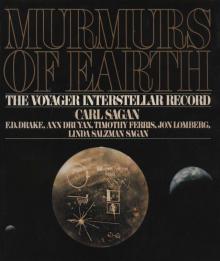 Murmurs of Earth
Murmurs of Earth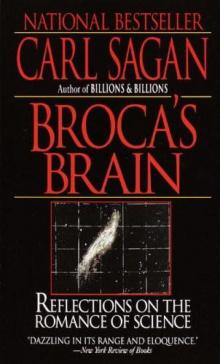 Broca's Brain
Broca's Brain Comet
Comet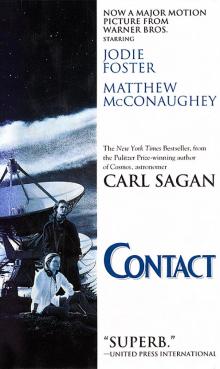 Contact
Contact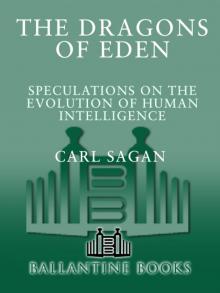 Dragons of Eden
Dragons of Eden Cosmic Connection
Cosmic Connection Shadows of Forgotten Ancestors
Shadows of Forgotten Ancestors Billions & Billions
Billions & Billions Comet, Revised
Comet, Revised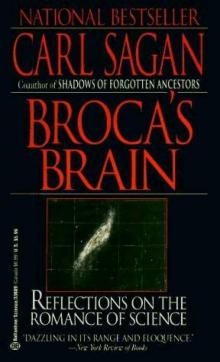 Broca's Brain: The Romance of Science
Broca's Brain: The Romance of Science The Varieties of Scientific Experience: A Personal View of the Search for God
The Varieties of Scientific Experience: A Personal View of the Search for God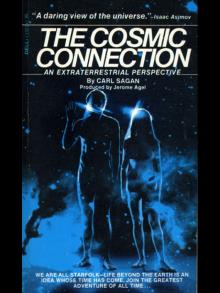 The Cosmic Connection
The Cosmic Connection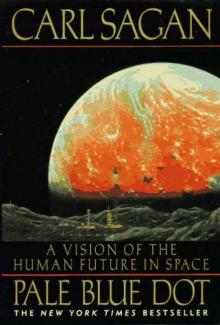 Pale Blue Dot: A Vision of the Human Future in Space
Pale Blue Dot: A Vision of the Human Future in Space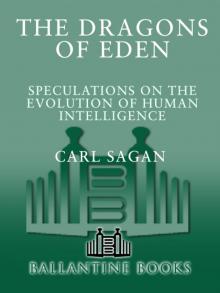 The Dragons of Eden
The Dragons of Eden